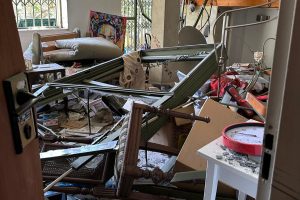In the mid-1980s, Hartmut Hosenfeld was teaching in Attendorn, Germany, about the Second World War. He asked his students to find out who lived in Attendorn before the war, and recommended they talk to their grandparents to find the answer.
When the students came back the next day, they reported that only Roman Catholics had lived there prior to the war. Troubled by this answer, Hosenfeld told the students to search further, pointing them toward a local newspaper article from April 1933 that bore the headline: “Boycott Jewish Owned Businesses”.
Shortly after, Hosenfeld visited Israel. The trip solidified his interest in the Jews of Attendorn, and he embarked on a project to research the community. Since then, he has published a book about the Jews of Attendorn. And his students took on the task of caring for the local Jewish cemetery.
Two years ago, my brother-in-law Daniel visited Attendorn, the birthplace of his grandmother. Impressed by the well-kept cemetery, he contacted the mayor of Attendorn, Christian Pospischil. Grateful for the positive feedback, Pospischil told Daniel about the town’s plan to unveil a monument to the Jews of Attendorn who died in the Holocaust.
The ceremony took place last month and marked the 80th anniversary of Kristallnacht. The town also dedicated the memorial stone at the cemetery in memory of the 17 local Jews murdered in the Holocaust.
Seven of them were members of the Ursell family, who had lived in Attendorn for hundreds of years. Forty-five Ursell ancestors attended the ceremony, travelling from Canada, Israel, the U.S., England, Chile, and Costa Rica. One branch of the family, descendants of Julius Ursell, are Quakers (Julius was attracted to the pacifism of the Quakers after he fought in the First World War.) Their Quaker connections helped them escape Germany. Some of the family members only found out they had Jewish origins months before the trip to Germany.
READ: POLL REVEALS MANY BDS SUPPORTERS HAVE ULTERIOR MOTIVES
In Attendorn, we saw posters advertising the events commemorating Kristallnacht. There was artwork, concerts, lectures, theatre, and the memorial unveiling. The town called the event, “Attendorn Shalom, 2018.” Another local teacher, Marlies Backhaus, conceived of an art project where students would choose a photo of one of the Jewish children of Attendorn and imagine that they were the godparent of the child.
As the students got involved in the project, they became fascinated with their “godchildren.” The artwork included two portraits on each panel – one a photo of the Jewish child, and beside it a selfie of the student involved in the project.
The students left a collective message, too. “Shalom, dear friends from the past! We never got to know each other. Eighty years ago you were cast out of our common hometown of Attendorn. It was during the horrible era of the Holocaust, which left its marks even in provincial towns like Attendorn. In our (virtual) project, we play music together, we play sports together, we go to the same school or simply chill under a colourful starry sky… Our faces gaze at each other in front of a painted picture, leaping across history. Welcome!”
Attendorn’s Jewish cemetery is small, located on a hill overlooking the town. On the day of the ceremony, more than 200 Attendorn citizens stood quietly and respectfully in the cemetery as we arrived. The men all wore hats; many also donned kippahs. They thanked us for coming. Dignitaries spoke, including the mayor and a member of the state parliament. A student quartet played music. A rabbi who represented the region sang the mournful song of El Malei Rachamin, the hymn to Jewish martyrs, and recited Kaddish.
There are no Jews living in Attendorn today. But on that moving day, local musicians played Jerusalem of Gold as the sun set over the unveiled memorial. And as their notes went up to heaven, a moment of peace and kindness stretched across the world. Attendorn, Shalom 2018.






